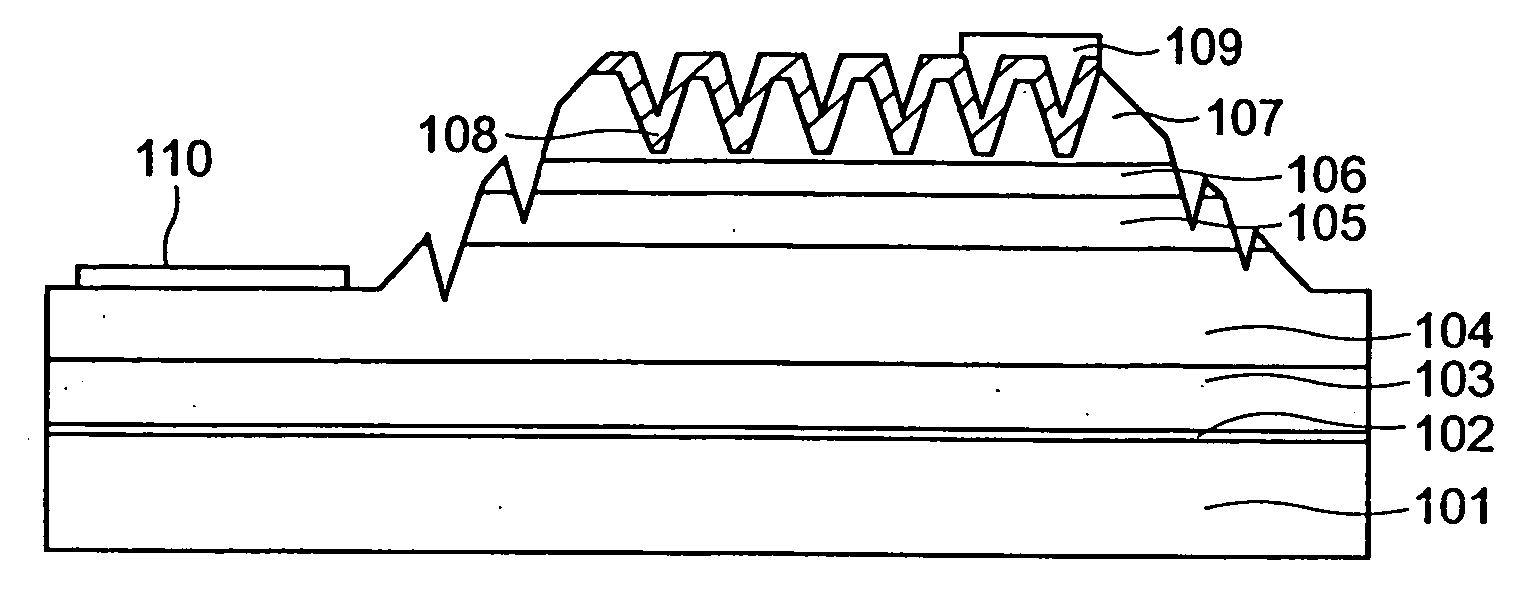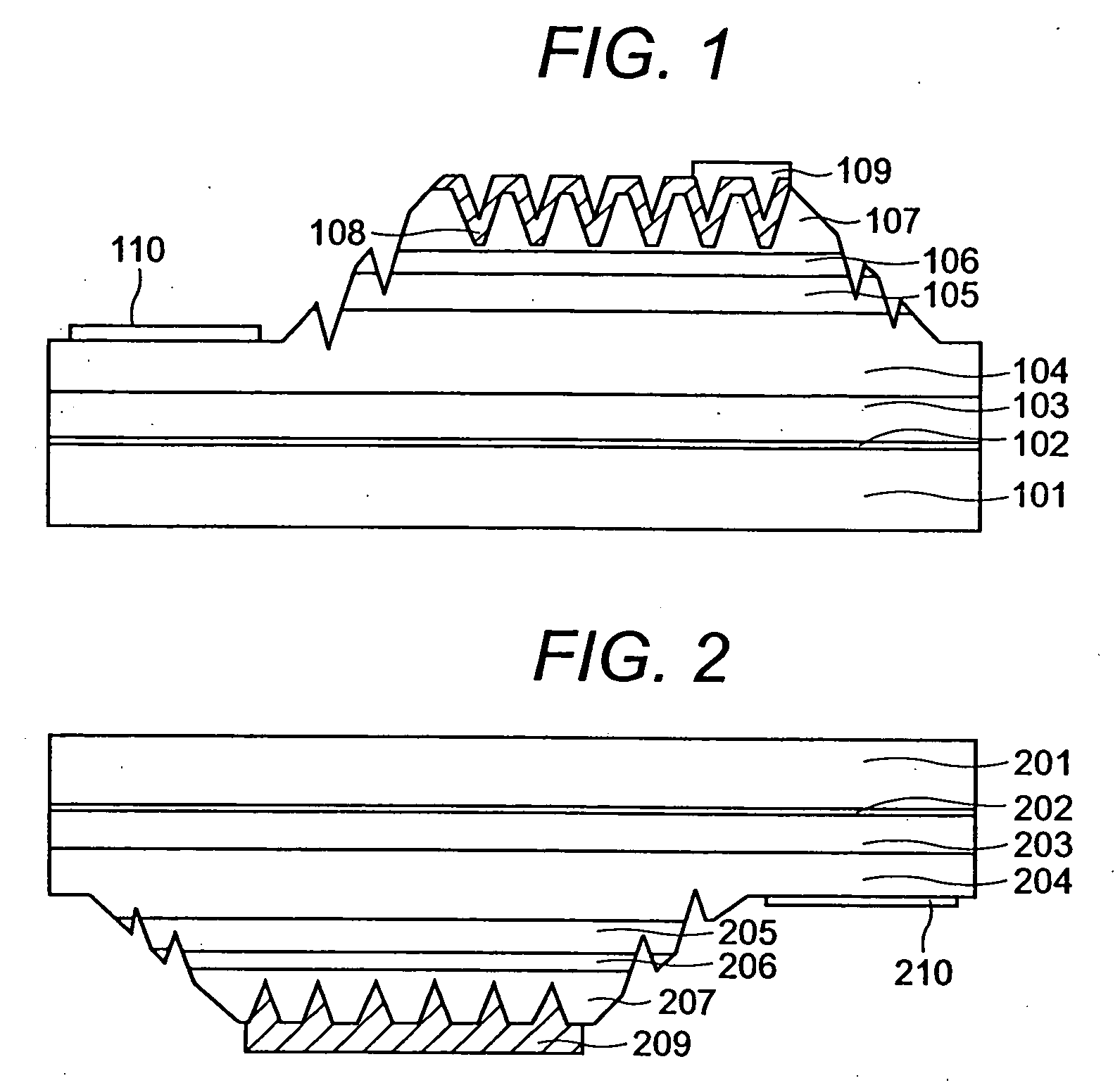Light emitting diode and manufacturing method thereof
a technology of light-emitting diodes and manufacturing methods, which is applied in the direction of basic electric elements, electrical equipment, semiconductor devices, etc., can solve the problems of difficult growth of gan-based materials on a flat surface, high light extraction efficiency, and low production cost of low-cost electrode pads. achieve the effect of improving light extraction efficiency and avoiding the adverse effect of low-cost electrode pads
- Summary
- Abstract
- Description
- Claims
- Application Information
AI Technical Summary
Benefits of technology
Problems solved by technology
Method used
Image
Examples
embodiment 1
[0149] The method of manufacturing the prior art light emitting diode (LED) as a basis will be first described with reference to FIGS. 15 and 16.
[0150] According to the MOVPE method, a LED structure emitting blue light was grown on a substrate (501 or 601), having a diameter of 2 inches, composed of a sapphire with surface C. To put it more specifically, a substrate (501 or 601) composed of sapphire was put into a MOVPE apparatus. Then it was heated in the atmosphere of a nitrogen / hydrogen mixed gas of 760 Torr (overall flow rate=150 slm; nitrogen / hydrogen=2) at 1135 degrees Celsius for 10 minutes, whereby the oxides were removed from the surface of the substrate (by thermal cleaning).
[0151] After that, the substrate temperature was reduced to 515 degrees Celsius. At the same time, the flow rate of the carrier gas was set at 140 slm and volume ratio of nitrogen / hydrogen in the carrier gas was set at 1.5. Under this condition, ammonia (NH3) gas as a nitrogen material was put into t...
embodiment 2
[0176] In the LED structure of the first embodiment, epitaxial wafers were manufactured wherein the number of undoped In0.15Ga0.85N layers in the InGaN / GaN multiple quantum well layer (active layer) (105, 205) is 1 through 50. A prior art surface light extraction type LED structure and a surface light extraction type LED structure having bores were formed on the surface in the manner similar to the first embodiment were manufactured from each epitaxial wafer.
[0177]FIG. 4 shows the number of the quantum well layers and the rate of output increase (the maximum light emitting output obtained from the LED structure with bores formed on the surface / outputted light emitting output of the prior art LED structure) resulting from formation of bores on the surface. As shown in FIG. 4, when the number of the quantum well layers is more than 30, the light emitting output is not increased even if bores are formed on the surface (the rate of output increase: 1 or less).
[0178] This is due to an ...
embodiment 3
[0179] As shown in FIGS. 5 and 6, in the LED structure of the first embodiment, a Si doped n-type Al0.1Ga0.9N layer (111, 211) having a Si density of 3×1018 cm−3 was inserted between the n-type GaN layer (104, 204) and InGaN / GaN multiple quantum well layer (active layer) (105, 205).
[0180] An epitaxial wafer for a blue-violet LED (emitted light wavelength: 400 nm) was manufactured, wherein the active layer of this blue-violet LED was an InGaN / GaN multiple quantum well layer (active layer) (105, 205), this InGaN / GaN multiple quantum well layer being composed of a 6-cycle, Si doped n-type GaN layer having a density of undoped In0.06Ga0.94N (film thickness: 3.5 nm) / Si of 3×1018 cm−3.
[0181] Then the same experiment as that in the first embodiment was conducted. Similarly to the case of the first embodiment, a considerable increase was observed in the light emitting output over the prior art LED structure under the following conditions:
[0182] 1) The percentage of the area occupied by t...
PUM
 Login to View More
Login to View More Abstract
Description
Claims
Application Information
 Login to View More
Login to View More - R&D
- Intellectual Property
- Life Sciences
- Materials
- Tech Scout
- Unparalleled Data Quality
- Higher Quality Content
- 60% Fewer Hallucinations
Browse by: Latest US Patents, China's latest patents, Technical Efficacy Thesaurus, Application Domain, Technology Topic, Popular Technical Reports.
© 2025 PatSnap. All rights reserved.Legal|Privacy policy|Modern Slavery Act Transparency Statement|Sitemap|About US| Contact US: help@patsnap.com



